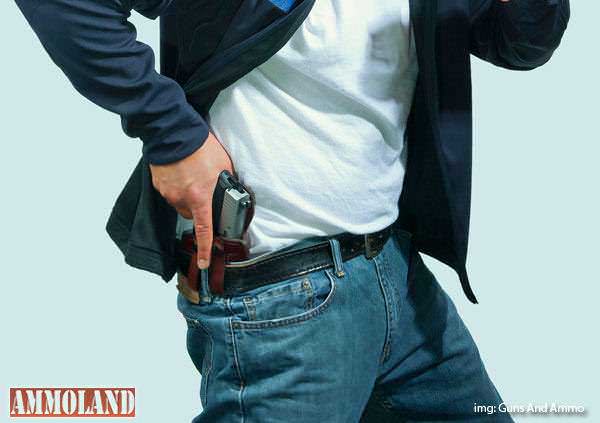
U.S.A. –-(Ammoland.com)- For the serious concealed weapon carrier, there is an understanding that weapon retention skills are essential. A majority of lethal force encounters happen within six feet and develop very quickly. While we train on the range at sometimes crazy distances, the reality is that if things go bad, they will do so at what is called “bad breath distance.” With a weapon being presented in such close proximity to an assailant it is essential to understand that they may try to interfere with the weapon or more problematic, actually take the weapon. With that in mind let’s explore three retention techniques to cover three basic scenarios.
Draw Stop
The draw stop occurs when an assailant sees you beginning to draw your weapon and moves to stop the draw from occurring. The technique used to counter this is as follows:
- Keep your gun hand on the weapon and sink your center down. The attacker’s hand is near your weapon and your first goal is to keep them from taking your weapon from the holster. Keep your drawing arm close to your body and press the weapon into the holster.
Keep your drawing arm close to your body and press the weapon into the holster. - Turn your weapon away from the attacker. This will force them to reach further to maintain contact. The more spread out they are, the easier it will be to deal with them.
Turn your weapon away from the attacker. - With your support side hand now, strike down into the arm of the attacker. The goal is to break their grip and allow you to get some distance. The primary target is the muscle on the upper forearm. In fact, to be even more effective strike the side of the muscle. Strike hard and with your entire body behind it. Follow though is important with striking and you should strike as if you are going to cut through the arm. This technique delivers substantial energy to the strike and improves its’ effectiveness.
With your support side hand now, strike down into the arm of the attacker. The primary target is the muscle on the upper forearm. In fact, to be even more effective strike the side of the muscle. - After you strike the arm down, use the same hand and execute a finger strike to the eyes. The primary purpose of this motion is to drive the person back. People respond instinctively to eye attacks and they naturally begin to withdraw. Once contact is made, focus on shoving the head back.
After you strike the arm down, use the same hand and execute a finger strike to the eyes. - Now that their arm is down and they are leaning back, you should immediately slide to the rear and off the line at a 45° angle. Make the motion significant to get as much space between you and the attacker as possible. Space is essential at this point so take what you can get quickly.
- Present your weapon and continue to move back and away at a 45°. Do not plan on standing your ground. This is where training will determine the level of success of your experience. You must train and develop the ability to shoot on the move.
Present your weapon and continue to move back and away at a 45°. Do not plan on standing your ground.
Gun Grab – Downward Pressure
This occurs when the attacker grabs the gun after you have cleared your holster and are in the process of raising the muzzle to the target. They then try to drive the muzzle downward in an attempt to take it from you. The fundamental principle behind dynamic weapon retention is called “blending.” If the attacker pushes, you pull. If they pull, you push. This “blending” neutralizes any strength or leverage advantages the attacker may have.
- As the attacker pushes the weapon downward, blend with that motion and avoid a shoving match.
This “blending” neutralizes any strength or leverage advantages the attacker may have. - As you flow with their push, step back with your dominant foot to turn yourself at a 45° angle to the attacker. They will now be spread out physically as they are forced to reach to maintain their grip. The more spread out they are, the weaker their position will be.
As you flow with their push, step back with your dominant foot to turn yourself at a 45° angle to the attacker. - Now with speed and energy, continue that same path the attacker was pushing the gun in and snatch it from their grip. This must be done with 100% commitment and intent. If not, the attacker will be able to hang on and a tug of war will ensue.
Now with speed and energy, continue that same path the attacker was pushing the gun in and snatch it from their grip. - After the weapon is out, simply let the weapon follow its’ natural path up into your shooting position. It is also essential that you continue to put space between you and the attacker. More than likely they will attempt to attack you again in order to liberate your weapon.
After the weapon is out, simply let the weapon follow its’ natural path up into your shooting position. - Bring the weapon to bear on the attacker using a close quarter’s arm position. This will put you in a stronger framework if a second attack comes.
Bring the weapon to bear on the attacker using a close quarter’s arm position.
Gun Grab – Upward Pressure
This occurs when the attacker grabs the gun after you have cleared your holster and are in the process of raising the muzzle to the target. They then try to drive the muzzle skyward in an attempt to take it from you. As with the downward push, you must blend with the attack in order to improve your chances for success.
- As the attacker grabs the gun and pushes upward, blend with the motion thus avoiding a shoving or wrestling match.
As with the downward push, you must blend with the attack in order to improve your chances for success. - As the gun is pushed upward, turn at a 45° angle to the attacker and let the gun arc up. This will put the attacker in a weaker and more vulnerable position. While you may be tempted to, do not let go of the gun at this point to strike unless you have been professionally trained to do so. Retention is our first priority.
As the gun is pushed upward, turn at a 45° angle to the attacker and let the gun arc up. - As the weapon reaches the apex of its arc, accelerate it in its’ natural path now down and away from the attacker. The gun will come free form their hands. Execute this with an explosive fast motion in order to snatch the gun away from the attacker. If the motion is timid, the chances of success drop significantly.
As the weapon reaches the apex of its arc, accelerate it in its’ natural path now down and away from the attacker. - Immediately put space between you and the attacker. As with all scenarios of this nature, we must expect the attacker to continue their assault. There will be no time to admire your handiwork.
Immediately put space between you and the attacker. - Bring the weapon to bear on the attacker using a close quarter’s arm position. This will put you in a stronger framework if a second attack comes.
Bring the weapon to bear on the attacker using a close quarter’s arm position.
These techniques are physically easy yet they are psychologically difficult. This is the case because we tend to quickly turn physical conflict into pushing and pulling matches. We seem to be programmed to meet force with force at times. The ability to blend is a learned skill and takes as much mental training as it does physical training. If you are young, large, and strong then force may work to your advantage. There are two truths that we must embrace however. First is that strength is a fleeting thing. If all you ever rely on is brute force, you will eventually fail. Second is that the attacker we face may be much larger. In fact, regardless of your size, there is always someone bigger and stronger out there. By blending with the attack we eliminate all of that.
A related topic you should consider is a well-made holster and gear. A strong holster can make the difference between retention and failure. Simply tucking a weapon in your jeans at the small of your back is not ideal for retention or effective carry. Friction retention holsters are very popular and effective when worn correctly. These are molded holsters that hold the gun in place by simple friction. The second type of holster seen in the concealed world has a mechanical retention device. These can serve a roll in certain situations, but mechanical retention holsters are primarily designed for exposed carry situations. The device can slow your presentation and interfere with your draw. Some are devotees of this system but you are encouraged to explore all options and see which one fits you best.
Last, it is important to carry your weapon in a manner that makes retention easier. While open carry is a legal right in many areas, it leaves your weapon open for an attacker to see. From a tactical angle, this puts you at a distinct disadvantage if things turn bad quickly. Rather than being a statement about the social implications of open carry, this is purely a tactical point.
In the end, know that there will always be a chance that an attacker may grab your gun. By professionally preparing for that scenario you can better defend yourself against the danger that comes with it. You become a well-rounded professional and responsible concealed carrier.
About Fred Mastison
Mr. Mastison is a professional instructor in the fields of defensive tactics, firearms, and executive protection. He is a reserve police officer and has been training in close quarter combatives for over three decades. He is recognized internationally as one of the top combatives and firearms instructors in the world. He also operates an executive protection division and provides services around the world.
Mr. Mastison is a published author on the subject of Defensive Tactics training and firearms. As a freelance writer and has written over 300 articles for national magazines.



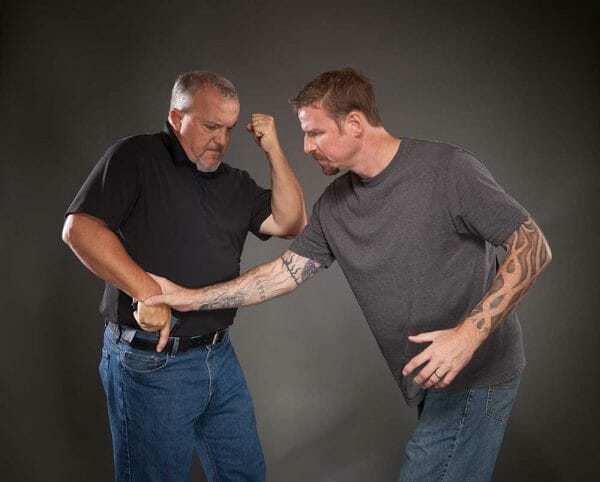
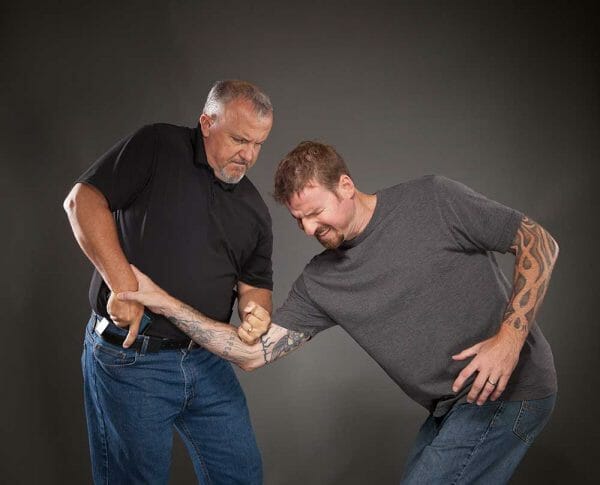

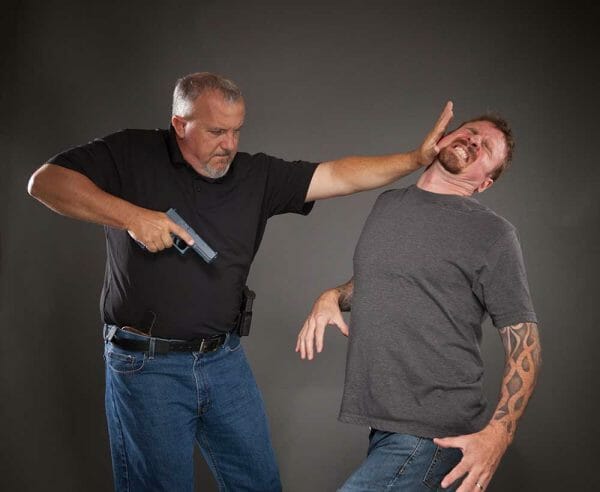
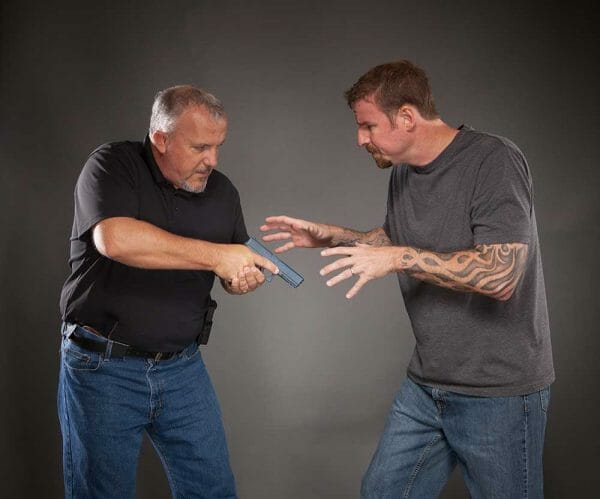


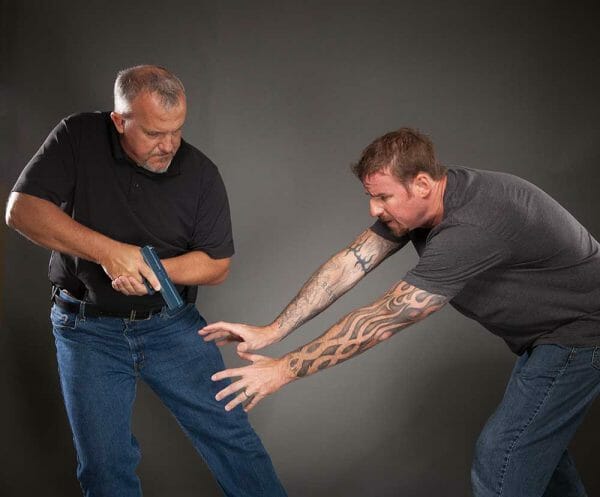
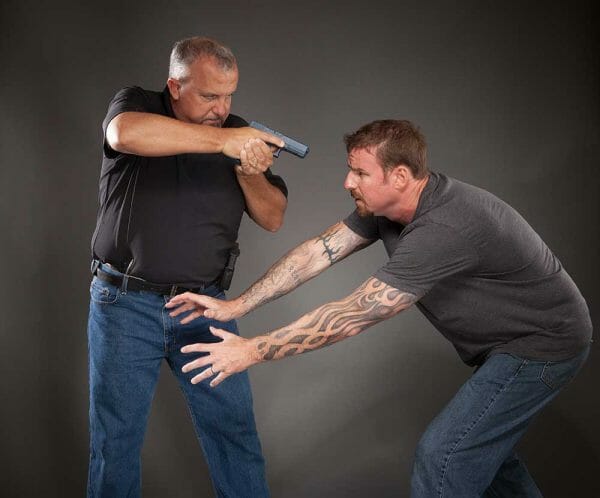


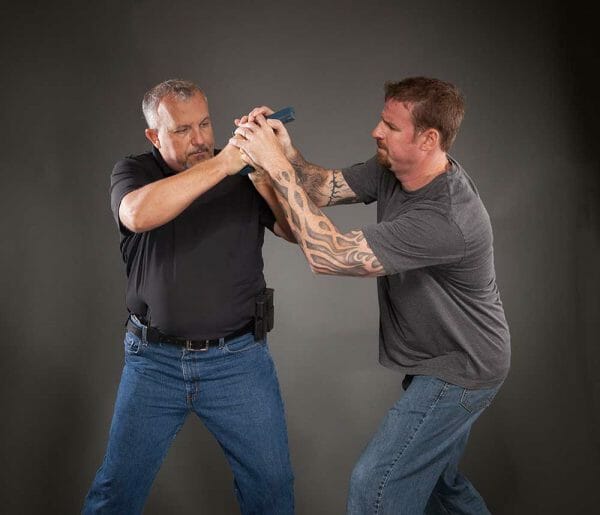
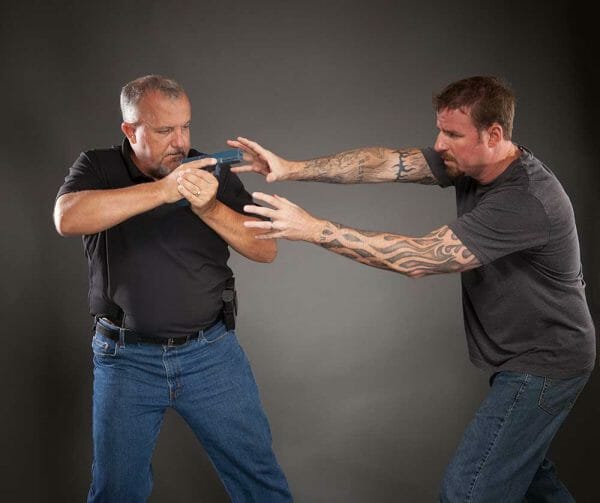
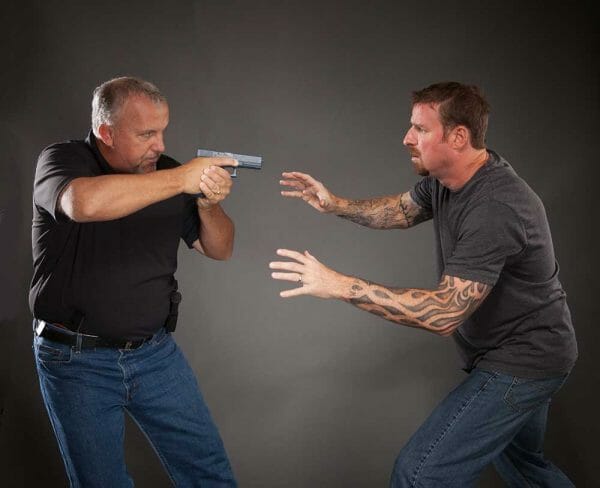

Pretty neat stuff. However, I always carry a belt feed M-60 (I’m old school). If they grab the belt or the attached door gunner beer can feed ramp what can I do?
Scott,
Notice that none of these scenarios have the ending written into them. Likely for a reason. Maybe it’s because up until you pull the trigger you are always processing data. Maybe the circumstances or back drop have changed during the struggle? Maybe other innocent civilians have entered the area of conflict or professional back up has arrived.
Your approach is akin to the Judo I learned before Karate came along. The throws were used to take advantage of your opponents own movements and motion. If practiced it can be very effective.
Well, that is one way. A lot of people carry an accessible and deployable knife for their support hand for this very situation. Imagine the defender with a knife in his blocking hand, and then recompute for another solution.
Great info here. My problem is from looking at your last picture. At that point you have retained control of your firearm but the attacker is still very close to you AND you still have your finger off the trigger. If I were the attacker I would be watching your trigger finger and still see an opening for another move since it takes time to react to that move and get your finger where it should be at this point. Please let me know if you think that my analysis is wrong.